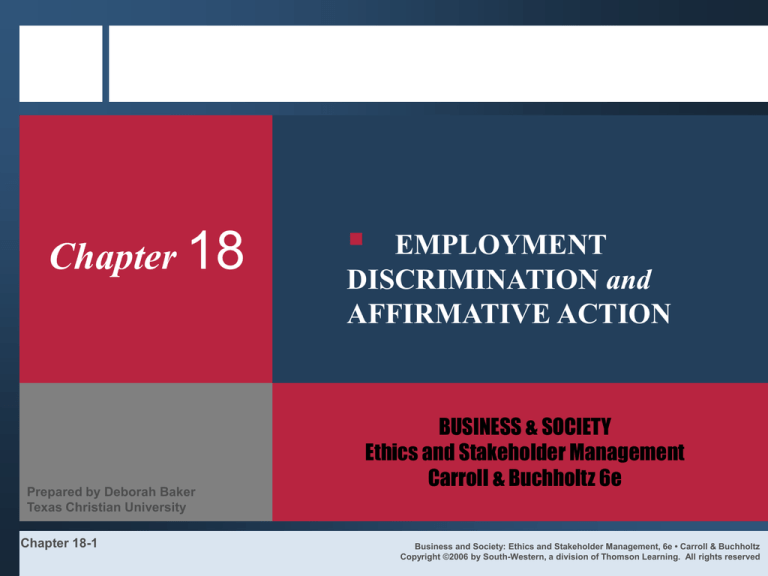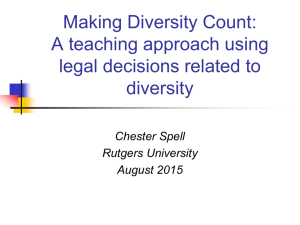
Chapter 18
Prepared by Deborah Baker
Texas Christian University
Chapter 18-1
EMPLOYMENT
DISCRIMINATION and
AFFIRMATIVE ACTION
BUSINESS & SOCIETY
Ethics and Stakeholder Management
Carroll & Buchholtz 6e
Business and Society: Ethics and Stakeholder Management, 6e • Carroll & Buchholtz
Copyright ©2006 by South-Western, a division of Thomson Learning. All rights reserved
Chapter 18 Outcomes
1.
Chronicle the U.S. civil rights movement and minority
progress for the past 50 years.
2.
3.
Outline the essentials of the federal discrimination laws.
4.
Elaborate on employment discrimination relating to race,
color, national origin, sex, age, religion, and disability.
5.
Identify the different postures with respect to affirmative
action, explain the concept of reverse discrimination, and
provide an overview of the Supreme Court’s decisions on
affirmative action.
Provide two different meanings of discrimination and give
examples of how each might be committed.
Chapter 18-2
Chapter 18 Outline
Chapter 18-3
The Civil Rights Movement and Minority Progress
Federal Laws Prohibiting Discrimination
Expanded Meanings of Discrimination
Issues in Employment Discrimination
Affirmative Action in the Workplace
Summary
Federal Anti-Discrimination Laws
Title VII of the Civil Rights Act of 1964: Prohibits discrimination in hiring and
other aspects of employment on the basis of race, color, religion, sex, or
national origin.
Age Discrimination in Employment Act of 1967: Protects workers 40 years old
and older from arbitrary age discrimination.
Equal Pay Act of 1963: Prohibits sex discrimination in payment of wages to
women and men who perform substantially equal work.
Rehabilitation Act of 1973, Section 503: Prohibits job discrimination on the
basis of a handicap.
Americans with Disabilities Act of 1990: Gives individuals with disabilities
civil rights protections similar to those given to individuals on the basis of
race, sex, national origin, and religion.
Civil Rights Act of 1991: Provided increased financial damages and jury
trials in cases of intentional discrimination.
Chapter 18-4
Expanded Meanings of Discrimination
Disparate Treatment
Disparate Impact
Direct discrimination
Indirect discrimination
Unequal treatment
Unequal consequences or results
Decision rules with a
racial/sexual premise
Decision rules with
racial/sexual consequences
Intentional discrimination
Unintentional discrimination
Prejudiced actions
Neutral, color-blind actions
Different standards for different groups
Same standards, different
consequences for different groups
Chapter 18-5
Sexual Harassment
Circumstances
The victim as well as the harasser may be a woman or a
man. The victim does not have to be of the opposite sex.
The harasser can be the victim’s supervisor, employer’s
agent, a supervisor in another area, a coworker, or a
nonemployee.
The victim does not have to be the person harassed, but
could be anyone affected by the offensive conduct.
Unlawful sexual harassment may occur without economic
injury to or discharge of the victim.
The harasser's conduct must be unwelcome.
Chapter 18-6
Selected Key Terms
affirmative action
Age Discrimination in
Employment Act (ADEA)
Americans with Disabilities
Act (ADA)
bona fide occupational
qualification
Civil Rights Act of 1991
color bias
comparable worth
Chapter 18-7
compensatory justice
disparate impact
disparate treatment
Equal Employment
Opportunity Commission
(EEOC)
Equal Pay Act of 1963
fetal protection policies
four-fifths rule
major life activities
Selected Key Terms (continued)
preferential treatment
Pregnancy Discrimination
Act of 1978
protected groups
reverse discrimination
sexual harassment
strict scrutiny
Title VII of the Civil Rights
Act of 1964
Chapter 18-8






